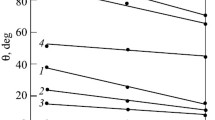Abstract
The influence of the oxygen content of copper on its wetting of, and bonding to, tungsten has been investigated in detail using sessile-drop and pull-out strength tests. As little as 41 ppm of oxygen has been found to inhibit wetting and to result in bond strengths of less than 2 ton/in.2 (3.2 kg/mm2).
Similar content being viewed by others
References
M. Nicholas andD. M. Poole,Appl. Matls. Res. 4 (1965) 247.
M. Hansen, “Constitution of Binary Alloys”, 2nd edition (McGraw-Hill, 1958).
“OFHC Brand Copper-Technical Survey” (American Metal Climax Inc, 1961).
M. Nicholas andD. M. Poole, AERE Report No. R-4843 (1965).
L. D. Lucas,compt. rend. 253 (1961) 2526.
A. Kelly andW. R. Tyson,J. Mech. Phys. Solids 13 (1965) 329.
R. F. Tylecote,Sheet Metal Industry (January 1946).
D. W. Petrasek,Trans. AIME 236 (1966) 887.
Author information
Authors and Affiliations
Rights and permissions
About this article
Cite this article
Nicholas, M., Poole, D.M. The influence of oxygen on wetting and bonding in the copper-tungsten system. J Mater Sci 2, 269–274 (1967). https://doi.org/10.1007/BF00555384
Received:
Issue Date:
DOI: https://doi.org/10.1007/BF00555384




